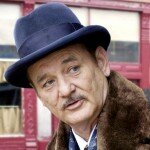In 2004, an eccentric Polish/Australian nudist with Tourette’s syndrome went to the Academy Awards – and emerged clutching a golden statuette. I’m talking about Harvie Krumpet of course, the title character of Australian director Adam Elliot’s Oscar-winning clay animated short film.
Five years, 132,480 frames, 212 puppets and 133 sets later, Adam Elliot is back with his first full-length feature film Mary and Max.
Based on a true story, the film tells of the pen-pal relationship of young, lonely Melbourne girl by the name of Mary Dinkle (Toni Collette) and a 44 year-old obese, autistic New Yorker called Max Horovitz (Philip Seymour Hoffman). If this doesn’t sound like your typical animated film, that’s because it’s not. Much like Harvie Krumpet, Mary and Max uses the magic of clay animation and an abundance of humour to tackle a wide assortment of societal issues – from alcoholism to religion, suicide to Agrophobia. And here you thought lonely trash compacting Robots and Kung-Fu fighting Panda’s made for an interesting story…
With Mary and Max opening around the country on April 9th, I had an opportunity to talk with Adam about the appeal of clay animation over CG, the challenges and delights of working on his first feature and how he has nicknamed his Academy Award the “Golden Crowbar”.
Anders Wotzke: Animation is traditionally a family friendly style of cinema, yet your films tend to dabble with a wide range of mature themes. Who would you say your intended audience is for a film like Mary and Max?
Adam Elliot: Good Question, but I have no idea! (laughs) I like to mix it up; I like to challenge distributors and film festivals because they never know how to program my films. Really though, at the end of the day I’ve made this film for everybody. That might sound a bit cheesy, but it’s for all ages and races and it’s proving to be a film for all ages and races! There is dark subject matter in there, and I probably wouldn’t show the film to anyone under the age of 8. Although, someone bought a five year old the other day and she loved it! I’m sure she didn’t know there was suicide in it.
Some people start off thinking it’s a kids film, without realise it has adult themes. But that’s the nature of animation; you really can reach audiences on all levels, kids watching it on one level, adults watch it on another. Pixar and Dreamworks do the of course – although this is not a Shrek or a Nemo, put it that way.
AW: Far From it!
AE: It’s weird though, in America one reviewer said that he really liked the film, but he wasn’t sure if it was a film for kids. Two days later we got into the Berlin film festival in the Kids section – who were all aged 14 – and they gave us a prize!

Dealing with an assortment of societal issues,
|
AW: Nowadays, most animated films are Computer Generated. What is it about clay animation that keeps you coming back?
AE: Well, we could have made Mary and Max as a CGI film easily. Or we could have done it as a 2D animation like The Simpsons. But it really comes down to personal choice. I love getting my hands dirty, and we employed of 120 people for the film – painters, sculptures, armature makers and costume designers- who are all likeminded craftsmen. If I was a computer animator, I think I would get frustrated very quickly sitting in front of a computer every day, drinking coca-cola. (laughs) It’s great to get plasticine under your fingernails. We also use a lot of timber, so there is a lot of carpentry going on as well. It’s a real mix of all these hand crafted skills.
AW: What advantages do you think Clay Animation has over CGI?
AE: I think audiences love seeing things on the big screen they know are not computer generated. When they see the fingerprints on the plasticine, they know that it hasn’t been generated by a computer, and there’s something magical about that. That’s why I think the art form is here to stay, and will never go away!
AW: Having only written screenplays for short films in the past, what were the biggest challenges you came across when writing a feature film?
AE: When I first started I thought; “ah, it’ll be just like making five Harvie Krumpet’s in a row!” Well I was completely wrong! (laughs) A feature film has its own set of criteria, its own rhythm and pace. It was really like starting from scratch. I’ve never written a feature film and, to be honest, I was terrified. I thought; ‘Oh god, I’m not going to come up with 80 pages of script!” But then suddenly, I had 100 pages and I had to edit it back! So I just lacked the self esteem I should have had. It’s very challenging though; I love writing, but it’s really tough and you got to be disciplined.

Max’s character is based on Adam’s
|
AW: While you continue to use a narration to tell your stories, one aspect to Mary and Max that you hadn’t really dealt with in the past was that of character dialogue. Was this a challenge to write for the first time?
AE: It was, it was. In this film, because I wanted the characters to be as real and authentic as possible, it meant that I had to match that with authentic and real dialogue. Because the film is based on my pen friend in New York, I really re-read his letters and worked out his speech patterns. I worked out how people with Asperger’s structure their sentences; there is a certain oddness in the way people with Asperger’s often speak, so I did a lot of research. I thoroughly investigated autism – with my pen friends permission – and spent a year writing the script.
AW: I guess the hardship pays off when you have the likes of Philip Seymour Hoffman, Toni Collette, Barry Humphries and Eric Bana voicing the characters. How did they get on-board the film?
AE: As I was writing the script and as the characters started to evolve, I started writing down names of who I thought might be appropriate. You know, not actually expecting to get any of these names. (laughs) Like with character Damien, I thought; ‘well it would be good if Eric Bana did this because he’s from Melbourne and he’s played greek characters and he’s eastern European himself’. Then for Max I thought of Philip Seymour Hoffman; I’ve been a big fan of his for years, his career was starting to skyrocket and he’s a New Yorker. But I didn’t want actors who had been in lots of animated films – like Dustin Hoffman and Jack Black and all those. They are just in everything! So I put [Hoffman's] name down, and had this ‘wish list’.
Once the script was finished and we started physically making the film, my producer Melanie Coombs approached all their agents and managers and, well, we then got them all! We were gobsmacked when we actually got the actors we wanted! (laughs) We didn’t have the budget to sort of pay them what they normally would get, so it was really because they all just loved the script.

Adam Elliot clutching the “Golden Crowbar”
|
I mean, with Philip, it did take a while to get him. It took us almost two years to actually get him because you have to penetrate the shield of all these managers and agents, and we didn’t have much money. But we had the Oscar; we call it the “golden crowbar” (laughs), it really helps to break these shields! But when he actually physically got the script and read it he said yes instantly – they all did – because of the writing, which was really nice.
AW: Mary and Max contrasts and critiques two distinctive cultures; suburban Australian and urban American. How have audiences belonging to these two backgrounds responded to seeing their society on-screen, warts and all?
AE: Oh, it was very nerve wrecking showing the film at Sundance [Film Festival]; I mean we were the first Australian film ever at Sundance on opening night and the first animated feature on opening night. Luckily, half the film was set in New York, but we weren’t sure what the New Yorkers, were going to think. But it was overwhelmingly good, they all said the film resonated in both worlds – both here and in America – and that has been really reassuring!
I mean, there’s always risk you might upset somebody, but so far so good! I thought I might upset the gay and lesbian community, but I haven’t. I haven’t upset any New Zealand sheep farmers… yet! (laughs) The Greek community don’t hate me yet, so…so far so good!
Read Part Two of my Interview With Adam Elliot: “I write my scripts from anger”
 Follow the author Anders Wotzke on Twitter.
Follow the author Anders Wotzke on Twitter.










